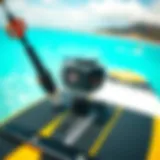Exploring the World of Foilboarding: A Complete Guide


Intro
Foilboarding has emerged as a thrilling frontier in the world of water sports, captivating the hearts of avid kiteboarders and adventure enthusiasts alike. This innovative sport, blending elements of traditional kiteboarding with cutting-edge foil technology, opens up a realm of possibilities on the water. Understanding the various aspects of foilboarding—from its origins to the intricate details of gear and techniques—unlocks a deeper appreciation for a sport that is not just a fleeting trend, but rather a testament to human ingenuity on the waves.
In this article, we will dive into the mechanics of foilboarding, tracing its fascinating history while also providing crucial insights into the necessary gear and techniques that both beginners and seasoned riders should familiarize themselves with. We will touch on safety measures and explore renowned global hot spots where riders can practice and perfect their craft.
Gear and Equipment
When it comes to foilboarding, having the right gear is paramount. Unlike traditional kiteboarding, which relies solely on a kite and a board, foilboarding introduces a third dimension—literally—thanks to the foil that elevates the board above the water. Here, we'll outline essential gear for novices as well as advanced equipment for those who are ready to take their skills to the next level.
Essential Kiteboarding Gear for Beginners
- Foilboard: Your main piece of equipment that lifts you above the surface. For beginners, a larger board with more volume is preferable, providing stability and ease of use.
- Kite: A suitable kite is crucial. Look for models that are designed for beginner use, offering stable flight and control. Brands like Ozone and Naish have excellent options.
- Harness: This is what keeps you attached to your kite. Ensure it's a comfortable fit and provides good back support.
- Wetsuit: Safety against the elements is key. Depending on the water temperature, choose a wetsuit that allows for flexibility while keeping you warm.
- Safety Leash: This is often overlooked but essential for preventing accidents. It keeps your board secure if you fall off.
Advanced Equipment for Experienced Riders
- Performance Foilboard: As you gain confidence, opt for a smaller, more performance-oriented foilboard that offers agility and speed.
- High-Aspect Foils: These foils allow for greater lift and efficiency, making them ideal for advanced maneuvers.
- Custom Kites: Experienced riders might prefer kites optimized for different conditions—lighter for strong wind and heavier for lighter wind days.
- Specific Harnesses: Look into hybrid or impact vests that not only provide comfort but also extra support during high jumps or tricks.
Techniques and Tips
Mastering foilboarding requires more than just the right gear; understanding the techniques is equally important. Here, we will go over some simple yet effective techniques that can enhance your skills and experience.
Safety Practices for Kiteboarding
- Know Your Environment: Before heading out, be mindful of local regulations and conditions. Research tide schedules, currents, and potential hazards.
- Buddy System: Always ride with a partner. They can assist you in case of an emergency.
- Wear a Helmet and Impact Vest: Falling can happen, and wearing protective gear minimizes injuries.
Training Techniques to Improve Your Skills
- Practice on Flat Water: For beginners, start on calmer waters where the conditions are less intimidating.
- Body Dragging: Before riding, practice body dragging to gain familiarity with the kite’s response.
- Controlled Take-offs: Focus on learning how to gradually lift off the water, maintaining control over your foilboard.
- Developing Balance: Spend time practicing simple maneuvers to build your balance and control on the board.
Foilboarding is more than a sport; it's a way to connect with nature and challenge personal limits. Each ride opens up an opportunity for discovery and skill improvement, transforming not just how we interact with water, but how we perceive our capabilities. Exciting spots to foilboard globally—such as Maui, Cape Town or the Outer Banks—await your adventure, offering the ideal backdrop to foster growth and expertise in foilboarding. For further insightful discussions, you can refer to resources like Wikipedia and community contributions on platforms like Reddit.
Keep riding, keep learning, and most importantly, enjoy the journey on the water!
Understanding Foilboarding
Foilboarding blends the thrill of water sports with cutting-edge technology, and gaining a solid grasp of this unique pastime is crucial for those who wish to immerse themselves in it. Understanding foilboarding opens the door to a wide range of experiences, from gliding effortlessly above waves to mastering intricate maneuvers.
The sport hinges on a foil, which is essentially a hydrofoil attached beneath the board. This component allows riders to lift above the water's surface, reducing drag and enabling smoother rides in various conditions. By comprehending the fundamentals of foilboarding, enthusiasts can better appreciate the techniques required and the mechanics involved. It also assists in recognizing common challenges faced by beginners and ways to negotiate them effectively.
Moreover, understanding foilboarding provides insight into innovation in the sport. With advancements in materials and design, the performance of foilboards continuously improves. This serves to attract new enthusiasts and retain seasoned riders, cultivating a community that thrives on skill and progression.
In summary, diving deep into the nuances of foilboarding not only enhances one’s riding capabilities but also enriches the sport's culture and community.
Definition of Foilboarding
Foilboarding, often known as hydrofoiling, is a water sport that involves riding a board mounted on a foil. The foil consists of a wing submerged below the water surface, allowing the board to rise above the water as it gains speed. This phenomenon occurs because the foil generates lift, akin to how an airplane wing operates.
When a rider takes off, the board can move smoothly over the water rather than against it. This reduces friction and enhances speed. While it may look effortless, mastering the balancing act between body weight and board orientation requires practice. Foilboarding can originate from various activities like kiteboarding, windsurfing, and surfing, broadening its appeal to a diverse audience.
History and Evolution
The roots of foilboarding trace back to the late 1960s when inventor Bob Woodward first experimented with the idea. However, it wasn't until the early 2000s that the concept truly gained traction, thanks to advancements in materials and technology. The early foils were rudimentary, often made from wood and aluminum. Riders had limited options and often faced challenges with stability and control.
In the years that followed, innovation picked up pace. The introduction of carbon fiber and other lightweight materials revolutionized the sport, providing foils that are both durable and efficient. As a result, foilboarding transitioned from a niche curiosity into a mainstream attraction for water sports enthusiasts.
Today, several companies design specialized foilboards, catering to different riders—from casual beachgoers to competitive athletes. The rapid evolution in foil design, alongside attention to safety standards, has made foilboarding more accessible and enjoyable than ever before. This history not only illustrates the progression of the sport but also highlights its capability for continual transformation, keeping it fresh and exhilarating for both newcomers and veterans alike.
"Foilboarding is a fine blend of art and science, marrying skill with engineering in a mesmerizing dance on water."
Mechanics of Foilboards
Understanding the mechanics of foilboards is vital for anyone looking to grasp what makes this sport tick. It’s not just about gliding over water; it’s the interplay of various components that enables the exhilarating ride experienced by riders. By delving into this section, we can appreciate how different parts of a foilboard work together harmoniously and how that influences performance on the water. Not only does this enrich your knowledge, it directly impacts your ability to choose the right gear and improve your own riding skills.
Components of a Foilboard
To put it simply, a foilboard can be broken down into three primary components: the board, the foil, and the mast. Each play an essential role in achieving lift and stability.
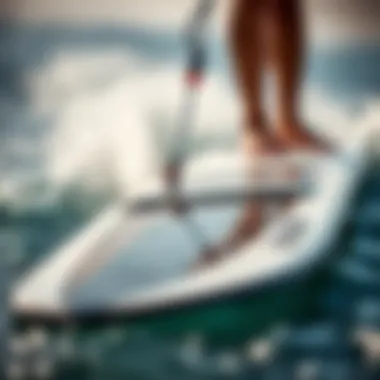
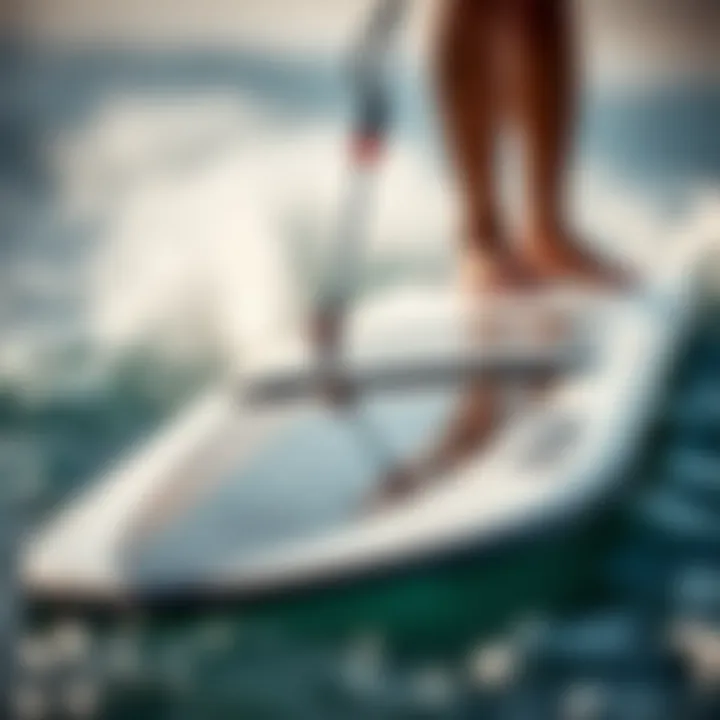
- Board: The surface you stand on, generally made from foam, fiberglass, or carbon fiber. The size and shape can affect buoyancy and maneuverability. For example, a smaller board tends to be more agile but may require more skill to balance on.
- Foil: This is akin to the wing of an airplane. It lifts the board above the water when the rider gains speed. Foils come in various shapes and sizes, which affect lift and drag. Some are designed for flat-water cruising, while others excel in waves.
- Mast: The long, vertical piece that connects the foil to the board. Its length can alter the rider's stance and dynamics. A higher mast might provide more clearance over water, perfect for choppy conditions or waves.
Getting to know these components allows riders to make better choices when purchasing or customizing their gear.
How Foilboards Work
At first glance, foilboarding may seem like magic—riding above the waves gives an otherworldly feeling. However, the science behind it is quite interesting and, dare I say, intricate.
As the rider accelerates, generally by using a kite or a paddle, water flows over the foil. When the speed picks up, the foil generates lift, raising the board above the water. This lift is a result of pressure differences created by the foil shape and angle against the water.
Here’s a quick breakdown of the process:
- Speed: The more speed, the more lift. It’s crucial to find that sweet spot.
- Angle of Attack: The angle at which the foil meets the water affects lift. A higher angle may increase lift but can also cause drag.
- Balance: Adjusting weight distribution is necessary for maintaining stability. Leaning too far forward or backward can send you crashing back into the water.
Understanding how these dynamics work gives riders the ability to control their performance and explore more advanced tricks over time.
"The thrill of foilboarding lies not just in the ride but also in how you command the forces of nature and technology together."
For anyone wanting to refine their skills or embark on their foilboarding journey, grasping the mechanics isn't just helpful; it’s essential. By knowing the components and understanding the operation, you set the stage for a more rewarding experience on the water.
Types of Foilboards
When it comes to foilboarding, the type of board you choose can make all the difference. Each style of foilboard caters to specific conditions, riding preferences, and skill levels. Understanding these various types allows a rider to make informed decisions that can enhance performance and enjoyment on the water. Let's dive a bit deeper into the categories of foilboards, examining how they align with different riding styles and environments.
Freeride Foilboards
Freeride foilboards are primarily designed for versatility. These boards provide a balance between stability and speed, making them suitable for a wide range of conditions and skill levels. Ideal for those who enjoy cruising around in various water conditions, freeride boards offer the flexibility to jump and maneuver without the complexities of niche-specific boards.
One key feature of freeride foilboards is their shape, which often includes a wider nose and a flatter bottom. This design allows for better lift and stability during takeoff and landing, especially for beginners who may not yet feel comfortable in the air. Plus, these boards typically come in various sizes, giving riders the advantage to select one that best suits their personal weight and skill level.
For aspiring foilboarders, a freeride board is often a good starting point, providing the foundation to develop essential skills without the intimidation that comes from specialized equipment.
Racing Foilboards
Racing foilboards are crafted with one purpose in mind: speed. These boards are longer and narrower than their freeride counterparts, which reduces drag and allows for faster movement across the water. The streamlined shape is coupled with a lighter build, often using high-performance materials like carbon fiber, which further enhances speed and responsiveness.
In races, every second counts, and a racing foilboard provides the competitive edge needed to outperform rivals. Riders typically adopt a more aggressive stance, leaning forward and straining against the wind to maximize acceleration. However, it's worth noting that these boards require a higher skill level due to their sensitivity and the need for precise control. Novices may find the learning curve steep, as any slight miscalculation can lead to a loss of balance or speed.
Wave Foilboards
Wave foilboards are particularly engineered for surf enthusiasts who want to ride the waves with a thrilling twist. Unlike freeride or racing boards, wave foilboards have more buoyancy and a distinct shape that allows them to catch and ride ocean swells effectively. They are usually shorter than other foilboards, which assists in maneuverability when tackling breaking waves.
The foil setup on wave boards is typically designed to maximize lift in choppy conditions. This leads to dynamic surfing experiences where riders can glide above the wave, maneuvering through various barreling sections. The balance between lift and control is crucial, and wave foilboards usually come equipped with larger foils to help navigate the unpredictable currents. Riders engage in a dance with nature, fully utilizing the energy of the ocean while enjoying the unique sensation of being airborne just above the waves.
"Choosing the right type of foilboard can turn a good day on the water into a fantastic one. It’s all about finding that synergy between you and the board."
Finale
Each type of foilboard holds significance in the world of foilboarding, bringing unique benefits and challenges. Riders need to consider their own preferences and intended use when selecting the right type of board. Whether cruising on a freeride board, racing against the clock, or tearing through waves, understanding these boards can elevate the experience, allowing for growth and mastery in the sport of foilboarding.
Techniques and Maneuvers
When it comes to foilboarding, mastering the right techniques and maneuvers can be the difference between gliding effortlessly above the waves or finding yourself tumbling in a messy fall. This section dives into critical approach for both novices and seasoned riders to elevate their skills and safety while foiling.
Getting Started
For those dipping their toes into the world of foilboarding, there’s an ocean of techniques to learn. The foundational skills – balance, stance, and control – are paramount. Here’s how to kick things off:
- Balance and Stance: Your feet should be shoulder-width apart, with most weight on your back foot. This position helps maintain control when you first get on the board. Consider it standing like a flamingo on one leg; stability is key.
- Initial Takeoff: Begin with a gentle pull from the kite. Too much power can lead to a tumble. Start small: practice repeatedly to gain confidence and feel how the foil lifts under you.
- Trimming the Kite: Get accustomed to adjusting your kite's angle. It’s essential for lifting off smoothly. A kite that’s too high might send you flying unexpectedly, while one too low will keep you grounded.
Often, the initial launches are the hardest, but one needs to remember: practice makes perfect. Starting in calmer waters, where spills won’t lead to injuries or frustration, is the way to go.
Advanced Maneuvers
Once the basics are under your belt, exploring advanced maneuvers can take your foilboarding to a whole new level. Here are a few maneuvers that will set you apart, capturing the thrill of riding the waves:
- Carving Turns: Lean your body weight into the turn while shifting your feet subtly, almost like you're surfing on smooth ice. Use the rail of the board to grip the water as you turn.
- Jumping: Initiating jumps requires precise timing. As you approach a wave or swell, push down on the board to load the foil. Then, as you feel the lift, pull the bar to get airborne. It’s a dance – get the rhythm right, and you'll be soaring!
- Backflips and Spins: These are the icing on the cake for experienced riders. Start by practicing jumps before adding the twist. Don't rush it; it requires perfect control and timing.
The essence of these maneuvers lies not just in execution but understanding how far your body can go without losing balance. Experiment and find your groove, you got this!
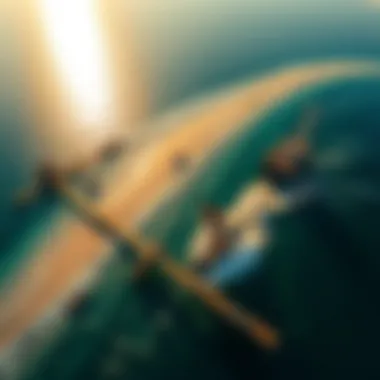

Common Mistakes
Getting into foilboarding can have its challenges, with many riders making common blunders along the way. Here are key mistakes to look out for and avoid:
- Overgripping the Kite Control: Clenching the control bar too tightly can lead to slower reaction times. Instead, maintain a relaxed grip to feel the kite's movements, allowing for smoother adjustments.
- Neglecting Safety Gear: Some riders feel invincible, but forgetting a helmet or impact vest is a rookie mistake that can lead to nasty injuries.
- Misjudging Conditions: Always check the weather. Strong winds can flip your session upside down, pun intended. The last thing you want is to be out in rough waters without the skills to handle it.
"Experience is the best teacher, and often the most humbling."
By spotting and correcting these common missteps early in one’s foilboarding journey, a rider can ensure a safer and smoother experience.
Further Learning
For those looking for more resources and community support as they dive deeper into the world of foilboarding, consider checking out forums and local groups on platforms like https://www.reddit.com/r/kiteboarding or following detailed guides available on en.wikipedia.org. These perspectives can provide fresh insights and techniques to keep your skills sharp.
Essential Gear for Foilboarding
To truly enjoy and excel in foilboarding, investing in the right gear is not just beneficial; it's essential. This section delves into the fundamental equipment that every rider should consider. The right gear enhances performance, safety, and overall experience on the water. Whether you're a seasoned pro or just dipping your toes into this thrilling sport, the right equipment can make all the difference.
Choosing the Right Foil
When it comes to foilboarding, the foil itself is the heart of the setup. Selecting the right one can mean the difference between soaring like an eagle or floundering like a fish. Foils come in various shapes, sizes, and materials, each tailored to specific riding styles and conditions.
- Foil Size: A larger foil provides more lift, which is ideal for lighter wind conditions and beginners. On the flip side, a smaller foil allows for quicker maneuvers, catering to advanced riders craving speed and agility.
- Wing Shape: The shape of the foil’s wings also plays a crucial role. For instance, slalom wings favor speed and less drag, while freestyle wings are designed to offer stability and ease of maneuvering. Considering what type of riding you aim to do will help narrow down your choice.
- Material: Most foils are made from aluminum or carbon fiber. Aluminum is generally more affordable and durable, whereas carbon fiber offers lighter construction and better performance but comes at a higher price point.
Choosing wisely here means not only enhancing your experience but also ensuring that the foil aligns with your riding goals.
Wetsuits and Safety Gear
The excitement of foilboarding comes with inherent risks, making safety gear paramount. Depending on the location and climate, having the right wetsuit can greatly impact your comfort and safety in the water.
- Wetsuits: When shopping for a wetsuit, consider the thickness and material. A thicker suit keeps you warm in chilly waters, while a thinner option offers more flexibility in warmer climates. Pay attention to fit; a snug wetsuit helps maintain body heat while allowing for freedom of movement.
- Impact Vest: An impact vest is a good idea, especially for those who are taking on high-risk maneuvers. These vests provide protection against impacts and increase buoyancy, which can be lifesaving in certain situations.
- Helmets and Safety Leashes: Invest in a durable helmet designed for water sports. A well-fitted helmet can protect against falls and unexpected encounters with equipment. A safety leash can prevent your board from drifting away, ensuring you keep it within reach.
In sum, ensuring you have the right wetsuit and safety gear not only enhances performance but also significantly increases safety while foilboarding. The water can be unpredictable, so this gear is a must-have for riding with peace of mind.
Remember: The right gear is your first line of defense against injuries and discomfort on the water. Don't cut corners here; invest wisely.
By understanding and choosing the appropriate gear, riders can elevate their experience and adventure in the field of foilboarding, whether it's the equipment that takes them soaring high above waves or the protective gear that keeps them safe.
Safety Considerations
Safety is at the forefront of any water sport, and foilboarding is no different. Understanding the risks and enacting best practices not only keeps you safe but enhances your enjoyment and confidence while riding those waves. The unique nature of foilboarding introduces specific elements that users must consider to mitigate potential accidents.
Understanding Risks
Foilboarding can certainly provide adrenaline-pumping thrills, but those thrills can come hand-in-hand with a few hazards. It’s vital to recognize that being up on a foil creates a height difference from the water, leading to different dynamics compared to traditional surfing or kiteboarding. Among the notable risks, we find:
- Falling Injuries: Falling at speed onto the water can lead to serious injuries, especially if the foil is still traveling at momentum. Getting acquainted with how to fall safely is crucial learning.
- Collision With Equipment: The board and foil can be sharp, and impacts can lead to cuts. Ensuring that you’re aware of your surroundings while riding can greatly decrease this risk.
- Environmental Hazards: Underwater rocks, shallow areas, or strong currents can pose threats that should be researched ahead of time. Knowledge of local conditions can make a huge difference in your safety.
- Weather Changes: Kite surfers should always monitor weather patterns. Sudden changes can create dangerous conditions on the water.
As the saying goes, "better safe than sorry,” and this rings especially true in the world of extreme sports.
Best Practices for Safety
Conducting oneself with care is ultimately the answer to mitigating risks while foilboarding. Here are valuable best practices to keep both newcomers and seasoned pros safe on the water:
- Wear Proper Safety Gear: Equip yourself with a helmet and impact vest designed for water sports. These essentials can protect from falls and general impacts.
- Know Your Equipment: Read the manual, learn how to adjust your foil setup properly, and ensure that your gear is adequately maintained. Faulty equipment can lead to mishaps.
- Learn Falling Techniques: Understanding how to fall correctly can save you from serious injuries. Try to keep limbs close to your body when you dive into the water to avoid the risk of impact.
- Check Local Conditions: Familiarize yourself with the water where you intend to foilboard. Inquire about potential risks and restrictions.
- Start in Flat, Open Water: When you first start foilboarding, aim for a calm spot free of obstructions. It will give you a safe environment to learn and practice.
- Keep a Safe Distance from Others: The exhilaration of foilboarding can cause you to lose awareness. Maintain a safe distance from other riders, swimmers, and boats to prevent accidents.
- Practice Good Communication: If you're out with a group, make sure everyone knows the plan and stays in communication. Having clear signals or using radios can aid safety significantly.
In the world of foilboarding, knowledge is just as powerful as your gear. Staying informed of the risks and implementing these best practices can provide a more enjoyable experience while keeping safety a priority.
"Safety doesn’t come from the equipment you use but from the knowledge and experience you have about the sport." - Unknown
For more info on safety in water sports, check out the U.S. Coast Guard.
By putting safety front and center, not only are you protecting yourself but you’re also encouraging a culture of thoughtfulness and awareness among fellow riders.
Popular Foilboarding Destinations
Exploring the right spots for foilboarding can truly amplify the experience for enthusiasts and beginners alike. The thrill of gliding above the waves combined with breathtaking backdrops can't be overstated. Different locations offer unique elements: wind conditions, wave types, and the overall atmosphere contribute to what makes each site special. Moreover, understanding the geographical layout, local environment, and seasonal influences allows riders to select the best times and places to practice this exhilarating sport.

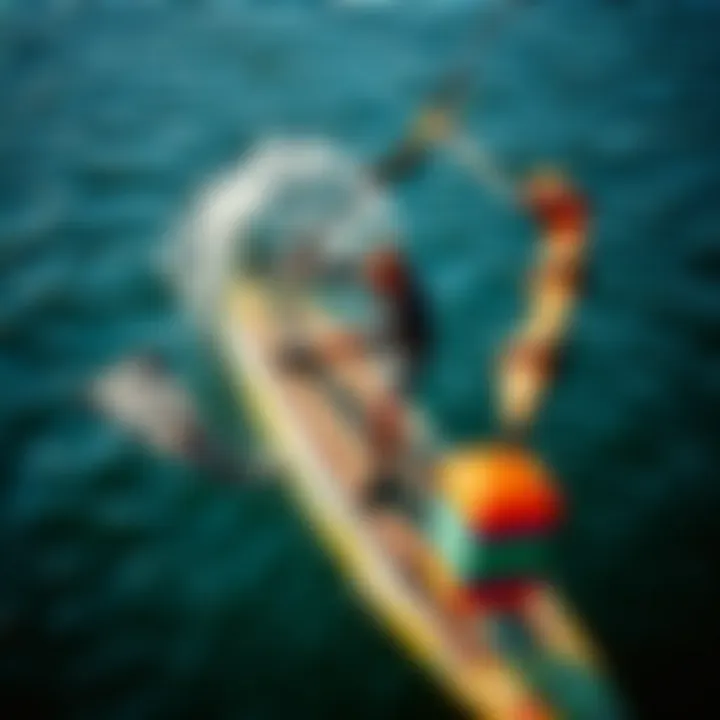
Top Coastal Locations
Some areas are renowned globally for their excellent foilboarding conditions. Here’s a closer look at a few standout coastal locations:
- Maui, Hawaii: Often labeled as the cradle of water sports, Maui boasts consistent trade winds and a warm climate. Spots like Kanaha Beach are particularly favored by foilboarders. The predictable winds and stunning scenery make for unforgettable riding experiences.
- The Gold Coast, Australia: Known for its surf culture, the Gold Coast also stands out for foilboarding thanks to its diverse wave patterns. The warm waters and vibrant marine life enhance the overall vibe, making it attractive for adventure seekers.
- Cape Town, South Africa: A hotbed for various water sports, the conditions here are nothing short of spectacular. The famous Table Mountain provides a stunning backdrop, while the winds of the Atlantic offer thrilling rides, especially in the summer months.
- Kite Beach, Dominican Republic: This haven attracts myriad kiteboarders and foilboarders with its pristine sandy shores and turquoise waters. The steady winds here provide the perfect set-up for anyone looking to hone their skills.
Each of these locations has its own charm and nuances, helping to cater to different skill levels and preferences. Whether you seek a bustling beach or a quieter cove, this diversity enhances the foilboarding community, inviting interaction among different riders from around the world.
Hidden Gems for Foilboarding
While popular destinations are lovely, there are often hidden spots that offer a more intimate experience. Places that might fly under the radar can provide a unique flavor and ample opportunities for exploration:
- Lake Ontario, Canada: Compared to coastal options, this freshwater lake has become a surprising hub for foilboarding. Its calm waters are ideal for beginners looking to practice their balancing skills, away from the crowded ocean waves.
- Cádiz, Spain: While not as widely recognized, Cádiz's lesser-known beaches present reliable winds and quaint atmosphere, appealing to those looking for a quiet getaway while still engaging in thrilling sports.
- Hvar, Croatia: This picturesque island is often less crowded than mainland spots. Hvar's sun-drenched shores and quiet bays allow for peaceful adventuring and exploration of the coastline.
- Lago di Garda, Italy: Known more for sailing, Lago di Garda offers hidden coves with fantastic foiling conditions, particularly in the afternoon when the thermal winds pick up. The surrounding mountains further enhance the scenery.
Each hidden gem can foster deeper connections within the foilboarding community, creating a space where riders can share tips, tricks, and stories without the noise of more crowded locales. The thrill of discovering a new place, coupled with the sport's challenge, expands what foilboarding means to many enthusiasts.
"Exploration is the essence of the human spirit; every wave we conquer leads to another adventure."
Community and Events
When one thinks about foilboarding, it’s easy to envision the thrill of carving through waves, catching air, or just gliding across the water with the wind in one’s hair. However, a significant part of the allure comes from the vibrant community that surrounds the sport. Engaging with others who share a passion for foilboarding can greatly enhance the experience.
The community aspect of foilboarding is important for several reasons. First and foremost, it fosters connections that can lead to friendships and shared adventures. Whether you are a seasoned rider or a fresh face in the scene, being part of a community allows you to enjoy the sport on a different level. Learning from each other, sharing experiences, and even just hanging out after a day on the water can be immensely fulfilling.
Additionally, the growth of foilboarding as a mainstream sport relies heavily on its community. Enthusiasts can serve as ambassadors, introducing new individuals to the sport, thus expanding the base of riders. This camaraderie encourages a culture of safety and sustainability, which is crucial for the long-term preservation of the environments where foilboarding takes place. A close-knit group often discusses best practices and recommendations, ensuring newcomers learn how to approach the sport with the necessary care and respect.
Furthermore, events and competitions play a pivotal role in uniting foilboarders. They create opportunities for athletes to showcase their skills, offer platforms for competition, and inspire others to get involved. Now, let’s discuss two key components of this community: foilboarding competitions and local foilboarding groups.
Foilboarding Competitions
Competitions in foilboarding are more than just about winning trophies; they are celebratory gatherings that highlight the sport's evolving nature and allow riders to show off their skillset against fellow enthusiasts. These events can vary widely, from local contests that cater to novice and intermediate riders to grand championships that attract professional athletes from around the globe.
The competitive scene offers several benefits. First, it provides riders with the chance to test their limits. Competing against others can reveal personal strengths and weaknesses, motivating participants to improve and master new techniques. Furthermore, spectators often gain inspiration and invaluable insights from watching seasoned competitors, which can enhance their own riding skills.
Often, these competitions create an atmosphere buzzing with energy and excitement. The sense of camaraderie found even in rivalry can make these gatherings memorable. It’s not just about the personal victory; it’s shared joy in the sport itself and fostering a sense of belonging in the community.
"Competition breeds excellence."
This old saying rings especially true in foilboarding, as riders continually push the envelope in terms of innovation and skill.
Joining Local Foilboarding Groups
If one wants to dive deeper into the foilboarding world, joining local groups is a fantastic way to get involved. These communities often comprise a diverse mix of individuals from various backgrounds and skill levels, providing a rich environment for learning and sharing.
Local foilboarding groups typically organize meet-ups, training sessions, and skill workshops. These activities not only help individuals improve their techniques, but also foster a sense of unity. There’s something empowering about riding alongside others, sharing tips, or simply enjoying a sunset after a day on the water.
In these groups, experienced riders often act as mentors to newcomers, providing guidance on everything from gear selection to safety considerations. Even casual conversations can yield gems of wisdom, such as discovering lesser-known spots for riding or learning about the gear that works best for certain conditions. The bonds formed through shared experiences on the water often turn into friendships that extend beyond just foilboarding.
Therefore, whether one opts to attend competitions or joins a local group, the sense of community in foilboarding underscores its significance in both enhancing individual experiences and furthering the sport at large. So, grab your foilboard, connect with others, and take the plunge into the exciting world of foilboarding!
The Future of Foilboarding
Foilboarding continues to carve its niche in the watersport scene, catching the attention of both seasoned kiteboarders and adventurous newcomers. The future of this exhilarating sport stands at a precipice, where advancements in technology and a growing community of enthusiasts are shaping its trajectory. As the adrenaline rush from gliding above the water captivates many, understanding the elements contributing to this sport's advancement is increasingly relevant. This section will explore two pivotal aspects: technological advancements and the potential growth of the sport itself.
Technological Advancements
The backbone of foilboarding's evolution lies in technology. Modern advances have significantly enhanced performance, safety, and accessibility. For instance, foilboard designs are not just refined for aesthetics but are engineered for efficiency. Lightweight materials like carbon fiber and advanced composite construction make boards more agile and responsive.
One primary area of innovation includes control systems. Remote setups that help riders adjust their foil's position mid-ride provide enhanced control, allowing for more intricate maneuvers and stability at various speeds.
Some noteworthy technological advancements in foilboarding include:
- Hydrodynamic Designs: More efficient wing designs reduce drag and improve lift, aiding riders in easier take-offs and prolonged flights above the water.
- Electric Foils: These powered boards are gaining traction, allowing users to experience riding even in less-than-ideal wind conditions. This opens the sport up to a broader audience.
- Smart Sensors: Integrated technology allows for real-time performance tracking, helping riders to gauge their skills and improve.
The continuous infusion of technology illustrates not just a progression in design but a trajectory towards creating a more inclusive and enjoyable riding experience.
Potential Growth of the Sport
As foilboarding continues to gain momentum, its growth potential is profound. Beyond the appeal of experiencing a unique sensation, the sport attracts a diversity of practitioners eager to explore challenges. The community is thriving, with local clubs popping up globally, fostering a sense of camaraderie among riders.
Factors contributing to the sport’s growth include:
- Increased Visibility: Exposure through social media and videography captures the thrill of foilboarding, inspiring a generation of enthusiasts and thrilling prospective riders. Websites like Reddit (reddit.com) and Facebook (facebook.com) showcase vibrant communities discussing tips, tricks, and locations.
- Evolving Events: As competitions become more mainstream, events like the World Kiteboarding League are incorporating foilboarding, drawing in larger crowds and showcasing elite talent.
- Accessibility: With gear becoming more available and affordable, more people can try their hand at foilboarding. Rental shops at popular coastal spots make it easier for novices to give it a go.
Ultimately, the future of foilboarding shines bright, supported by innovative technology and the enthusiastic backing of a growing community. As the sport adapts and evolves, it will not only attract more devotees but also evolve into a rich tapestry of experiences for all who dare to take on the water.
“Foilboarding isn't just about riding; it's about flying above the water and feeling the rush of freedom.” This sentiment echoes among many enthusiasts, encapsulating the allure of what lies ahead for this sport.


